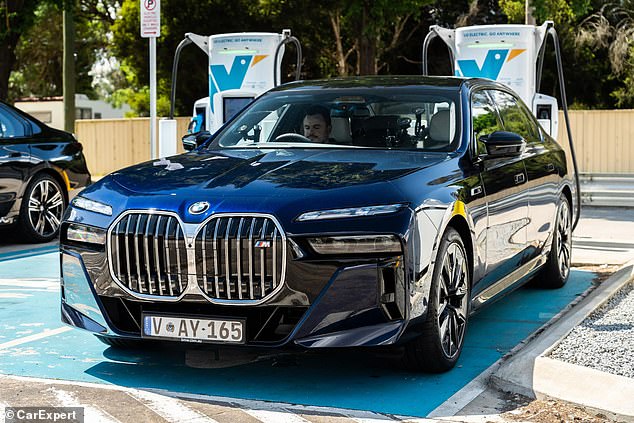Auto website CarExpert’s Sydney-Melbourne road trip reveals the shocking truth about whether EVs are cheaper to run than petrol cars
A long-distance test of equivalent electric and petrol vehicles has revealed the surprising result that the conventional car was cheaper to run.
More than 900 km drive from Sydney to Melbourne carried out by car website AutoExpert, The electric vehicle cost about $13 more in electricity than its gasoline counterpart – and also required an additional two hours of stop time to refuel.
This result echoes the findings of another motoring journalist who recently calculated that driving petrol and electric cars on the almost 300 kilometer three-hour journey from Sydney to Canberra was also cheaper with the combustion model.
CarExpert founder Paul Maric, who drove the EV, said they were just not practical for road trips in Australia.
“If you’re charging at home and driving in and around town, an electric car will always be the better option, but especially for road trips it’s probably not the type of vehicle I wouldn’t have on the bucket list,” he said. .
For the Sydney vs. Melbourne comparison, CarExpert purchased a new electric BMW 740i and the comparable petrol BMW i7 M70, which cost $344,900 and $272,900 respectively.
For the comparison between Sydney and Melbourne, CarExpert picked up a new electric BMW 740i and the comparable petrol BMW i7 M70
The vehicles departed and arrived together and were driven in almost identical fashion to make the comparison fair, with both starting with full fuel.
While we were traveling at the same speed, both the air conditioning and cooled seats were turned on.
The vehicles had two major fuel stops and a shorter one for a coffee break during the epic journey, which takes about nine hours non-stop.
At the stops, the EV used the fastest charger available, while the gasoline car used premium fuel.
However, there was a problem because the trip took place on November 8, the day the Optus network around Australia crashed.
This threatened to make the Evie network – which was the charging source at the first stop in the southern NSW city of Tarcutta – unworkable as an Optus connection was required for mobile authentication to make payments.
Fortunately, Mr. Maric, who was driving the i7, had his payment accepted after a few anxious hiccups.
Mr Maric was also alarmed that his car had only 2 percent charge left when he reached Tarcutta, which was about 110 km less than the estimated range the car had predicted on a full charge.
‘We chose to stop in Tarcutta because it was only about 450 kilometers from where we started, so we thought we could get there easily.’ said Mr. Maric.
The car had predicted that it could travel 574 km on a full charge, but that did not take into account the altitude difference from Melbourne to Tarcutta.
“You’re driving mainly uphill and once you have that elevation change you have a reduction in range, which in this case was 20 percent,” Mr Maric said.
This range uncertainty meant that Mr Maric said he would not attempt a road trip of longer than an hour in an electric car.
“My advice to people who want to take a road trip is to leave the electric car at home and rent a car if you’re going a long distance,” he said.
‘When Christmas comes, my wife’s Tesla stays parked at home and we take our other petrol car with us.
‘I don’t want to be stuck with a charger, I don’t want to be afraid of running out, especially when my wife and two-year-old are in the car because I’m getting divorced.
“Personally, I wouldn’t want my family to go on a road trip where I would have to rely on public charging infrastructure because that would be very expensive and reliability is a big question mark.”
During the three stops, the BMW i7 took two hours and eight minutes to charge, while the 740i only took about six minutes to refuel in total.
The big surprise came at the end when Mr Maric calculated that the i7 used 203.03 kWh of energy, costing $131.92, while the 740i used 56.16 liters of fuel, costing a total of $117.88.
This means that the electric car had an economical consumption of just over 20 kWh/100 km, while the car with a combustion engine consumed approximately 6 liters per 100 km.

During the 900 kilometer drive between Sydney and Melbourne, the BMW i7 M70 needed more than two hours to charge
Mr Maric also noted that Evie had increased her prices since the trip.
“Electricity prices have never fallen, so it will only get more expensive,” Mr Maric said.
“EVs are great to drive, but there are a lot of these risks that people don’t think about.
“If you just think about the average Australian who is just struggling to put food on the table right now, you’re talking about a vehicle like the Tesla Model Y that starts at $70,000 no matter what the tax incentives are , that’s still a big chunk of money.
“They want everyone to drive these things, but at the end of the day they’re just not affordable.”
Veteran automotive expert John Cadogan came to a similar conclusion in a YouTube post on Tuesday titled “Charging an electric vehicle now costs more than gasoline…”
“If you rely on public chargers, the electrons for your EV have just become more expensive than the actual liquid fuel for an equivalent conventional car,” Cadogan said.
‘This is madness.’

Veteran motoring journalist John Cadogan said he had ‘crunched the numbers’ on the price of driving similar petrol and electric vehicles between Sydney and Canberra
Cadogan said he “ran the numbers on a simple 300km road trip in a Mazda 3 versus a Tesla Model 3 and it is definitely cheaper to drive the Mazda from Canberra to Sydney.”
This was largely because Evie recently increased the price by 43 percent depending on the size and speed of the charger.
The result was that using the 150 kW Evie charger cost 68 cents per kilowatt hour, while in comparison the average NSW household pays just over 30 cents per kilowatt hour for power from the grid.
According to Cadogan, charging a Tesla Model 3 for the 300km journey to Canberra takes 40 minutes and requires 60 kW of power, which would be enough to power the average home for four days with a $40.80 charger .
Meanwhile, a Mazda 3 GT with a two-and-a-half liter engine uses about 7 liters per 100km on the highway, meaning it takes $37.80 worth of premium E10 fuel to drive from Sydney to Canberra.

Charging company Evie recently announced a price increase, which has hit EV users hard
Cadogan admitted that charging an electric car would remain cheaper if it could be done at home, but he said this was not possible for many EV owners in the inner city, without on-street parking.
“This kind of upward trajectory – some would say extortion – is a snapshot of what the electric utopia of the future will look like,” Cadogan said.
‘It is almost impossible to break even financially with an electric car, as the equivalent combustion engine car has such a ridiculous start in terms of purchase costs.
“It’s downright impossible to break, even if you’re forced to park on the street and therefore at the mercy of six months’ worth of price increases.”
Cadogan felt this largely debunks the myth that electric cars are cheaper, although he admitted this always seemed like a strange reason to buy one.
“It seems quite strange to me to pay $20,000 more upfront for an electric car compared to the cost of an equivalent internal combustion car if your only goal is to save money on fuel or something else,” he said.
‘If you have 40,000 euros or more to spend on a car, you can afford the fuel.’
